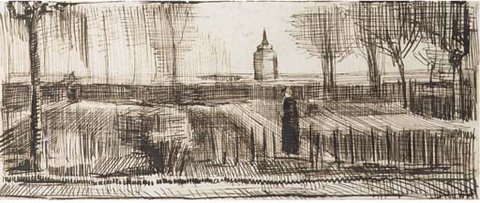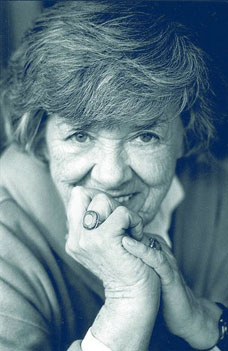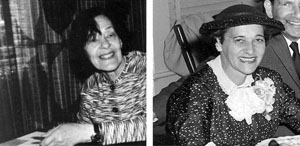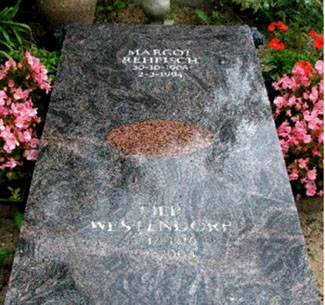
My Rehfisch Family – Part 2:
Margot and Fiep
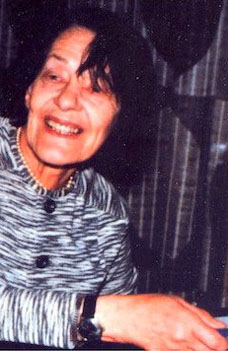
My mother's maiden name was Rehfisch, but all during my years researching my family's history, the name Margot Rehfisch never came up, until quite recently. It surfaced as a headline in a Belgian/Jewish newspaper, as part of a story about her and her partner. What made it so dramatic was that I didn't find her name in some musty public record, but in the subtext of a headline that turned up in a Google search, while looking for anyone named Rehfisch. That search turned up several news stories about a large gift that she had made posthumously, but it also included a partner of hers with the strange name of "Fiep". Unbeknownst to me, but well known throughout Western Europe, Fiep was the beloved Dutch illustrator and author of many children’s books, Fiep Westendorp. All the headlines were datelined Amsterdam, March 2005, and said that Fiep and her friend, Margot Rehfisch, left their extensive art collection to the Jewish Historical Museum in that storied Dutch City. From the proceeds of the sale, just a single Van Gogh pen drawing, called De Tuin van de Pastorie in Nuenen, sold at Christie’s Amsterdam for 120,000 euros ($161,000. USD), which later paid for the construction of a new children’s wing at the Jewish Historical Museum.
But other than her date of birth, October 30, 1908, in Berlin, she was just another Rehfisch, with no connection to me or my family. Nevertheless, her relationship with Fiep made it worth pursuing. I quickly learned, however, that it was far easier to find out about her iconic partner, Fiep Westendorp, than anything about Margot. The internet searches turned up her name on a couple of books: one was the title of her thesis/dissertation which had a very complicated technical name having to do with medical research; and much later an art book she did with Fiep. Then I found a solitary date in 1939, marking her arrival in the Netherlands. So, I assumed that she fled there from her home in Berlin sometime after Kristallnacht. But nothing more. That's when my friend, Lars Menk, came through, based on my desire to learn more about the other names on Sally Rehfisch's tombstone. (See Who Was Sally Rehfisch). Lars hit the mother-lode! Ironically it was a name he found that happened to be absent from Sally's headstone: Margot Rehfisch. And she turned out to be my cousin. Sally (Salomon) had three daughters. Herta, Erna and Margot. But on his headstone are only the names of his wife Julie and eldest daughter, Herta. This is not because they, too, are buried there, but as a tribute to them, since both perished in Sobibor in 1943. They were undoubtedly added by the surviving daughters, Erna and Margot, sometime after World War II. As is usual in genealogy, one major breakthrough like this raises all kinds of new questions.
In 2014, hoping that maybe I'd get some feedback about Margot from my readers, I posted a story on my blog about finding her and Fiep. But since I still knew precious little about her, the story was more about Fiep than Margot. Meanwhile, I continued my quest for information by contacting the Jewish Historical Museum, and the Fiep Westendorp Foundation, both in Amsterdam. At the foundation, a very helpful young lady gave me the name and address of a Ms. Hanny Hefting in Holland, who she thought might know something about my cousin. To contact her, I needed to write a letter in Dutch. Fortunately one of the members of my gym was from Holland. When I told him Margot's story, it immediately piqued his interest. And he quickly returned a complete translation of a letter I composed for him in English. Then I mailed both versions to Ms. Hefting. After that, every time I'd see my friend at the gym, he'd ask if I'd heard anything from her. But weeks went by with nothing from Holland. Then one morning my phone rang, and the first thing I heard was a falsetto voice at the other end cooing, "Hallooo! Is this Petah Vonlawwww?" At first I thought I was I being pranked! But no! It was Hanny on the line. She had chosen to phone me instead of writing—a great choice because we very quickly became best friends—on the phone. Having my letter translated into Dutch was totally unnecessary because she spoke perfect English. Hanny had lived in Australia for nineteen years. In that first phone call, she was eager to tell me everything she could remember about Margot at that moment. And she had a lot to say. Dr. Hefting, Hanny's father, was a successful physician in Amsterdam. He'd undoubtedly met Margot through his colleagues, since she'd already been a practicing physician in Berlin, with more than two years’ experience working at the Jewish Community Hospital there before the war. In late 1942, when Hanny was around 12 years old, the Heftings chose to hide Margot in their house in Amsterdam. They knew they did so at great risk to their own safety. Once Hanny’s father decided to hide her from the Nazis, Margot remained out of sight in the family household for the remainder of the war. Rarely, if ever, was she able to go outside because it was far too dangerous without the proper papers. Regrettably for my research, Hanny knew nothing about Margot's life prior to living with the Heftings. She said, “It was just too dangerous to know too much. So, the past was never mentioned and everything remained very hush hush.” As a result, how or when Margot got out of Nazi Germany still remains a mystery. However, she arrived in Amsterdam in 1939, after Kristallnacht, about the same time as the arrival of her cousin, my uncle Paul Refisch and his wife. In 1939 it was still easier to travel across the border to the Netherlands than it would have been had she waited any longer. The Nazis just wanted to expel the Jews, not exterminate them...yet. Assuming that they would be safe from the Nazis in Holland, both my cousin and my uncle made the same choice to immigrate to Amsterdam. For Margot it worked out because she did indeed reach safety. Sadly, Paul and his wife would not be so fortunate. In exchange for her protection, Margot worked as the Hefting's housekeeper. Often, when she'd dust the Hefting's grand piano, she would take a brief time out to play a few bars of Beethoven, before getting back to her dusting. Already in love with music, I'm sure that when young Hanny heard Margot play fragments of Beethoven in her home, it helped nurture her enthusiasm. Ultimately, Hanny went on to study at the Music Conservatory in Amsterdam. Although, Hanny never aspired to perform professionally, she continues to play at age 85, and still practices three to four hours a day on one of her two grand pianos. She relishes playing duets with professional friends of hers, by regularly having small recitals either in her home or the homes of musician friends in both Holland and Germany—all done for a few invited guests. So great is her love of music. But I digress... Hanny was able to find a picture of Margot, which she sent me. What I saw was something very familiar about her that reminded me of an old picture of my mother. When I found it, I was surprised by the uncanny resemblance between the two women. Yet it made sense since they were first cousins, sharing the same grandfather.
Once the war was over and Margot could come out of hiding, she was able to renew her goal to become a psychiatrist. But she had no intention of resuming her studies in Germany, choosing to remain in Holland instead. She finally received her license to practice a few years later. According to Hanny, Margot came to the United States in the 1950s, ostensibly on business. But I know that her older sister Erna lived in Queens with her husband, Martin Nachmann, and their son Guenter. So, business aside, it may well have been her first opportunity to see her sister since before the war. Having established a successful practice, by the 1960s she had both her home and office in Amsterdam. It was around that time that Fiep became one of her patients, and rented an upstairs apartment in Margot's house. Later, when Margot retired from practice, she bought a larger house in the country, where she developed a reputation for taking in sick animals and nursing them back to health. While no one seems to know for sure, this was probably when she and Fiep actually began living together. And so began their long relationship as life partners. Margot died on March 2, 1994 in Amsterdam, and was interred in the cemetery at Gemeentelijke Begraafplaats, Lauren, Netherlands. Although Fiep lived for another ten years, she shares the same burial plot with her partner—buried together in a double grave. It seems quite fitting, since they also owned an extensive collection of art treasures together that, after Fiep's passing, they had willed to the Jewish Historical Museum in Amsterdam. That brings us full circle, back to when I discovered the headlines publicizing their posthumous gift, and began my involvement in this research project.
As mentioned before, learning about Fiep was far easier than learning about Margot. A simple Google search not only brought up numerous bios about Fiep, but hundreds of reproductions of her delightfully quirky and whimsical illustrations (see samples here). Understanding my frustration at not being able to find more information about Margot before World War II, Hanny got me in touch with Fiep Westendorp's nephew, Hans, hoping that he knew more details about my cousin’s earlier life. Unfortunately, he did not. But he did send me copies of her academic records from her medical studies in Germany, before she fled to Holland. The records indicate that Margot’s education was extensive and that her goal was to parlay her education in Germany and continue her medical studies in America. But of course the war changed all of that. Nevertheless, here's a quick recap of what we do know about Margot's life prior to World War II: She began her medical studies in 1928 at the Albert Ludwig University, in Freiburg, Germany. Then in 1932 she transferred to the Friedrich-Wilhelm University in Berlin. In 1933 she attended the University of Vienna, which was probably her introduction to psychiatry. Then she transferred again to the German wing of the University of Basel in 1934. In 1935 her Thesis/Dissertation was published with this extremely technical title: Zur Frage der ursächlichen Beziehungen zwischen Trauma und Hypernephrom, which means, “The Question of the Causal Relationship Between Trauma and Hypernephroma”. A year later she began her internship at the Jewish Community Hospital in Berlin where she worked as a doctor/practitioner in the Internal Disease Ward, and later in the Tuberculosis Ward. In reading her documents, I found some curious questions about her education that will probably have to remain unanswered. For example: Her certificate of service at the Jewish Community Hospital in Berlin wasn't signed until December 1938, one month after Kristallnacht. Considering the fact that she was a Jew, it also seems odd that it was signed by the Home Secretary of the Reich. It's also seems odd that three years earlier the Nuremberg Laws were enacted, which decreed that “no Jew could study beyond age 14.” Could that have been why she stopped her medical studies at the University of Basel at the end of 1935, and began her medical practice at the Jewish Community Hospital in Berlin the following year? Yet, assuming her transfer to the Jewish Community Hospital was the beginning of her internship as a doctor, wasn't there still an educational component to it? So, either...
Nevertheless, thanks to my new friend, Hanny Hefting, I now know far more about my cousin Margot than I did before. And there may still be more to come. July 2016
Archives · Current Stories
|
||||||||||||||||||||||||||||||||||||
